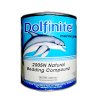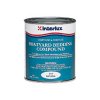To add to Dan's comment, bedding compound fills the tiny gaps between mating surfaces and therefore excludes water. Because of surface tension, water will readily wick between closely apposed pieces of material such as the mating surfaces between decks and gunwales, or between hardware and wood such as deck fittings. Especially where end grain is exposed, like the lateral edges of your canoe's decks, the ability of water to wick into the wood and cause rot is very high. Hence the use of bedding compound- less water access means less likelihood or speed of rot.
When you use a bedding compound, you should seal the mating surfaces first with varnish to prevent the bedding compound's oil from easily wicking into the wood. When oil wicks away because the wood wasn't first sealed, the oil becomes dispersed, the area becomes less water resistant, and water can the migrate into the wood and promote rot. This should suggest that bedding compound is not forever. It's not, but when used on sealed wood surfaces, it should keep water at bay for years.
I've used both Interlux Boatyard and Dolphinite. They both work fine, but I prefer the consistency and workability of Dolfinite to Boatyard. However, the Interlux is much cheaper. Jamestown sells a quart of Boatyard for $25, and a quart of Dolfinite for $35. You can get a pint of Dolfinite for $25 which means less to waste if you're doing only one or two canoes; Jamestown apparently doesn't carry Interlux Boatyard in a pint size.







